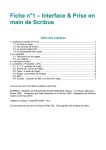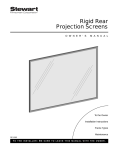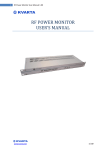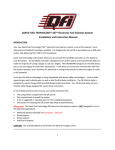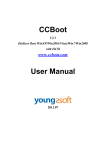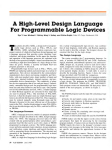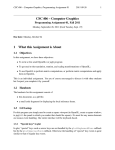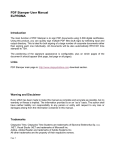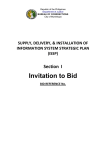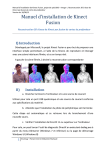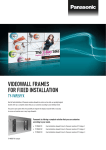Download REPORT READING & RESEARCH
Transcript
Brown University Department of Computer Science Laboratory for Engineering Man-Machine System (LEMS) REPORT OF THE READING & RESEARCH Supervisor: Gabriel Taubin Author: Yan Li February 2013 - December 2013 I. INTRODUCTION I have worked under the supervision of Prof. Gabriel Taubin since February on a project about videowall. The project involves the knowledge of computer graphics, computer network and synchronization. We thought that we could use the videowall in LEMS to develop some innovative applications and I started from there. The videowall is basically a 4x4 monitor matrix of 16 monitors. Since we have 16 monitors, it means that we have much more pixels to display. Therefore we came up with an idea: using the videowall to display something high-resolution like very large image or very fine mesh. The 4x4 monitors are driven by 4 computers and we treat the 4 computers as display servers. In addition to the 4 servers, we also have a master node machine which is just in front of the 4 servers. We use that master node to control the behavior of the 4 servers. So in this structure, the master node is like a client. Here is a snapshot of the above structure: I need to firstly develop a robust communication protocol between the master node machine and the 4 display servers. Also I need to take care of the rendering region for each of the servers because the servers are separate. I firstly ported a very simple 2D image viewer into my system. I used Java programming language and JOGL to handle the rendering part. Basically, each of the servers has a local copy of the image, and so is the master node. When the connection is built, each the 4 servers loads image locally but each of them picks a different area to render. JOGL has the property of clipping the unnecessary rendering region so that part is done in hardware with high efficiency. The program running on the master node is just used for manipulating the whole application globally. I then used this idea and developed a 3D mesh viewer using my system. It was more complicated because in a 3D scene, a camera is used to capture the image. However the idea was just similar and I just needed apply the idea on the near plane of the camera’s frustum. Finally, I developed a secondary client which can connect to the master node. Here the master node is more like a global server. There could be many secondary clients connecting to the master node. Once a secondary client connects to the master node, a new camera view will be assigned to it and it can move the camera freely to have a different view other than the global view. The client can also grab the global camera to manipulate the global view. Once one client grabs the global control, all of the other clients will be locked out. The information of all of the cameras will by synchronized to each of the clients and the master node. In addition, a visualization of the cameras’ position is made on both the display servers and the secondary clients. II. GOAL OF THE PROJECT The goal of the project is to develop a mesh viewer using the 16 monitors to display in a high-resolution way, and multiple clients can connect to the system. They are free to move the camera locally to have a different view of the currently displayed mesh. They are also free to grab the global control over the system to do something globally which will be synchronized to each of the clients. This application will be useful for a conference. If somebody wants to make a lecture using this system to display some large meshes, the audiences can just connect to this system, move its camera to look at the mesh freely and locally, or just look at the big screen to have a global view. So it will be ideal if this application can be ported to tablet or mobile devices because it would be cumbersome to always use laptop. III. MAIN CHALLENGES 1. The protocol of the communication between the master node and the display servers, and the protocol between the master node and each of the clients. 2. Each of the display servers should be able to pick up one region to display. Some matrix calculations are included. 3. The changes from the clients should be synchronized to the master node, display servers, and other clients. IV. DESIGN OF THE SYSTEM The structure of the system can be decomposed into two parts. The first part is the communication between the master node and display servers. The second part is the structure between the master node and multiple secondary clients. I use Java’s sockets to implement the network communication. 1. Structure of the master node and the display servers The structure is like the following diagram: Screens Screens Screens Screens Render loop Render loop Render loop Render loop Socket Socket Socket Socket Server1 Server2 Socket Socket Render loop Socket Server3 Socket User Interface Master Node Server4 Sockets for servers Here, the network protocol is simple: 1. Transformation of the all the cameras. (2D float array) (Transferred whenever the transformation of any camera is changed) 2. Frustum information of the camera. (2D float array) (Transferred whenever the frustum of any camera is changed) 3. Other settings.(The gap size of the video wall, topology position of each screen, etc) (Transferred when the connection is built) 4. Mesh name. (String) (Transferred whenever a new model is loaded) 5. Normal settings. (String) (Transferred whenever the normal setting is changed) 6. The ids of the used threads (Integer array) (Transferred whenever a new client is connected) 7. Number of max clients (Integer) (Transferred when the connection is built) 2. Structure of master node and secondary clients Render loop Socket User Interface Socket Socket … Sockets for clients Master Node Socket Client 1 Socket Client2 Socket … Client3 The network protocol is exactly the same with the protocol between the servers and master node except that it also includes the information of whether the global control is grabbed by one of the clients. V. USER MANUAL All of the system (display servers and master node) is located at LEMS at BARUS&HOLLEY building. The project is in the directory “\VideoWalls\3DIFSViewer\finalversion” of the repository. The display servers have already been configured so probably you don’t need to do anything trivial on it. Since the display servers are separated, I use synergy to simplify the mouse and keyboard control over the display servers. Synergy will be started once you boot the system and enter the login page. I recommend you boot the master node firstly and after you have logged in the master node, boot the 4 display servers. They will be connected to the master node automatically. You can use the mouse and the keyboard of master node to control the display servers. All of the source code is located in the repository. Before you start, firstly make sure that JOGL is installed in your machine and the path is included in the environment variable “CLASSPATH”. 1. Launch the display servers I have created a shortcut for each of the server on the desktop. Just click “run_videowall.bat” and it will launch. You have to do the same thing for each of the 4 servers. If you want to test it on your laptop, copy the project “OGL3DVWServer” from the repository and then compile it by clicking “compile_windows.bat” on Windows or running “./compile.bash” on Mac. To run it on the laptop in a test mode, either click “run_local_windows_server1.bat”, “run_local_windows_server2.bat”, “run_local_windows_server3.bat” and “run_local_windows_server4.bat” on Windows, or run “./run_local_machome.bash” on Mac. If you want more details or complicated start, open the source code “OGLVW3DServer.java” to see the argument lists. 2. Launch the master node and connect to display servers I have created a shortcut on the master node machine in LEMS, so just click “run_videowall_client.bat” on the desktop of that machine then the program will start. If you want to test it on your laptop locally, firstly copy the project “OGL3DVWClient” from the repository and compile it by clicking “compile_windows.bat” on Windows or running “./compile.bash” on Mac. If you want this program to connect to the video wall, click “run_videowall.bat” on windows or run “./run_videowall.bash” on Mac. If you want this program to connect your test servers on your laptop, click “run_local.bat” on windows or run “./run_local.bash” on Mac. After the program has launched, you will see the user interface which looks like the following: UI components: Open: start the connection to the display servers. Close: close the connection. Shutdown: shut down the servers if connected. Grid: show the frame of the display servers that is marked as red. 3. Launch the client Firstly copy the project “OGLVW3DSubClient” from the repository and compile it by clicking “compile.bat” on Windows or running “./compile.bash” on Mac. If you want this client to connect to the master node machine in LEMS, click “run_videowall_client.bat” on Windows or run “./run_videowall_client.bash” on Mac. If you want the client to connect to the local master node, click “run_local_client.bat” on Windows, or run “./run_videowall_client.bash” on Mac. After you have successfully launched the program, you will see the user interface that looks like this: UI Components: Open: Open the connection to the master node. Close: Close the connection to the master node. SHUT: Shut down the connection to the master node. GRID: Show the frame of display servers. SHOW CAM: Visualize other cameras locally. LOCK: Grab the lock over the global control of camera. LOAD: Load a mesh. Only available if you have grabbed the global control. NORM PER FACE: Change the norm to be per-face. Only available if you have grabbed the global control. NORM PER VERT: Change the norm to be per-vertex. Only available if you have grabbed the global control. VI. FUTURE WORKS 1. Synchronization mechanism between display servers There are a lot of future works and optimization that can be done. Firstly, there is no synchronization mechanism between the four display servers. It could be possible that some of the display servers go a little ahead of the others if we want to render a relatively large model. Currently, because we are using the same graphics cards and same processors in each of the display server, the rendering speed doesn’t differ too much. The user can hardly notice the lag between the servers. However, it will be more noticeable if using larger model. One of the possible ways to handle synchronization problem is to set up a barrier in the rendering loop. We can use socket to develop the inner mechanism by ourselves or use existed library like Open MPI. However this cannot make a perfect synchronization because the time of outputting pixels onto the screen may still differ. To make a perfect synchronization we have to develop hardware synchronization protocol on the graphics card. 2. Remotely loading a 3D model So far all of the test 3D models are stored locally in each of the clients, which means if you want to use the system properly, you have to not only have all of the executable files but also the 3D models. This is cumbersome because the user should only need to install the app and download the model from the air. Also it will be hard to manage because once you have new models, you have to let all of the clients update as well. The possible solution is to download the model when the client is connected to the system. The client should have a kind of progressive downloading mechanism because some of the models have super big size, and it will be miserable to just keep waiting. We can pre-compute the models of different resolution and store them in the master node. Once a client is connected to the master node, it will firstly download a small-size model to display on the client’s screen. After that the client progressively download the full-size model from the master node without disturbing the rendering loop. When it’s done, the client just destroys all of the small-size models and use the final version to render. 3. Other Platform It will be compelling if the client can support other platforms such as cell phone or tablets. Since the system is developed using Java, it shouldn’t be hard to port the code to other platforms as long as they have Java runtime environment. The only thing we need to learn is how to develop an app on mobile devices. 4. More features More features are expected to add to the system such as model editing and other more complicated operations like modifying the light in the scene. More feature means more synchronization between the client and the server, which also means more complicated protocol. VII. POTENTIAL BUGS One minor bug is about the normal. Sometimes the normal status (Per-vertex or Per-face) is not synchronized to the other clients and master node. I haven’t figured out the reason for this. VIII.RESULTS Snapshots of the system: (Image Viewer) (Mesh Viewer) (Mesh Viewer with multiple clients)


















